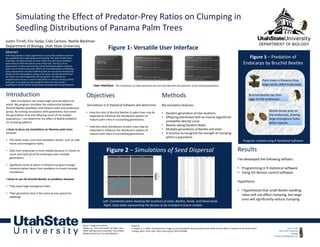
Spring18 bio-URS
- 1. Introduction Data simulations can reveal larger pictures about our world. My program simulates the relationship between Bruchid Beetles (predator) and Panama palm tree endocarps (prey). By running simulations with parameters that match the generation time and offspring count of my studied populations, I can determine the effect of Beetle predation on clumping patterns. I chose to focus my simulations on Panama palm trees because: • The seeds retain scars from predation events, such as claw marks and emergence holes. • Data from endocarps is more reliable because it’s easier to count and track all of the endocarps over multiple generations. • Significant study of palms in Panama has given enough characterization about their predators to create complex simulations. I chose to use the Bruchid Beetles as predators because: • They leave large emergence holes. • Their generation time is the same as one season for seedlings. Simulating the Effect of Predator‐Prey Ratios on Clumping in Seedling Distributions of Panama Palm Trees Methods My simulation features: • Random generation of tree locations • Offspring distributed with an inverse logarithmic probability density curve • Beetles taking Random Walks • Multiple generations of Beetles and trees • A function to recognize the strength of clumping within a population Results I’ve developed the following skillsets: • Programming in R statistical software • Using Git Version control software Hypothesis: • I hypothesize that small Beetle‐seedling ratios will not affect clumping, but large ones will significantly reduce clumping. Figure 2 – Simulations of Seed Dispersal Figure 3 – Predation of Endocarps by Bruchid Beetles Figure 1‐ Versatile User Interface Justin Tirrell Utah State University Biology tirrelljustin95@gmail.com Left: Coordinate plane showing the locations of trees, Beetles, Seeds, and Dead seeds. Right: Data table representing the factors to be included in future models. Program created using R Statistical Software Abstract Palm trees provide a unique opportunity to study what conditions optimize the probability that a seed will grow successfully. The seeds of palm trees, endocarps, are large and easy to locate. When they don't grow, predators leave marks on them that tell the story of their fate. The focus of my experiment is to determine how the current distribution pattern of parent palm trees in Panama palm trees affects the future distribution of seedlings. I have programmed a versatile model that takes the assumption that Bruchid Beetles are the sole predators acting on the seeds, and that these fall from the trees in an inverse logarithmic density pattern. The Beetles are programmed to move to a random seed within an arbitrary distance of their start point. If no seeds are near enough to them, then they starve. I hypothesize that the Beetles will decrease clumping within five generations.1 Justin Tirrell, Eric Sodja, Cole Carlson, Noelle Beckman Department of Biology, Utah State University. Objectives Simulations in R Statistical Software will determine: • How the ratio of Bruchid Beetles to palm trees may be expected to influence the distribution pattern of mature palm trees in succeeding generations. • How the initial distribution of palm trees may be expected to influence the distribution pattern of mature palm trees in succeeding generations. Figure 3 Image Attributions: “Attalea sp. , fruits and seeds” by Roger Culos “Male Callosobruchus maculatus” by limbatus “Attalea brasiliensis” by João Medeiros Palm trees in Panama drop large seeds called endocarps. Bruchid Beetles lay their eggs on the endocarps. Beetle larvae prey on the endocarps, leaving large emergence holes when mature. User Interface: This simulation can take input from the user that describes the dynamics of the existing population. Citations: 1. Wright, S. J. (1983). The Dispersion of Eggs by a Bruchid Beetle among Scheelea Palm Seeds and the Effect of Distance to the Parent Palm. Ecology, 64(5), 1016–1021. https://doi.org/10.2307/1937808